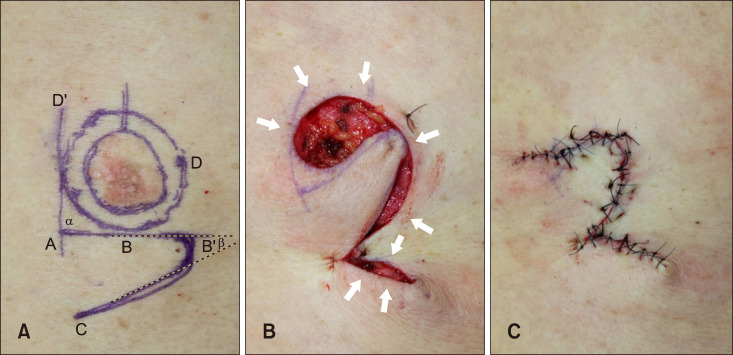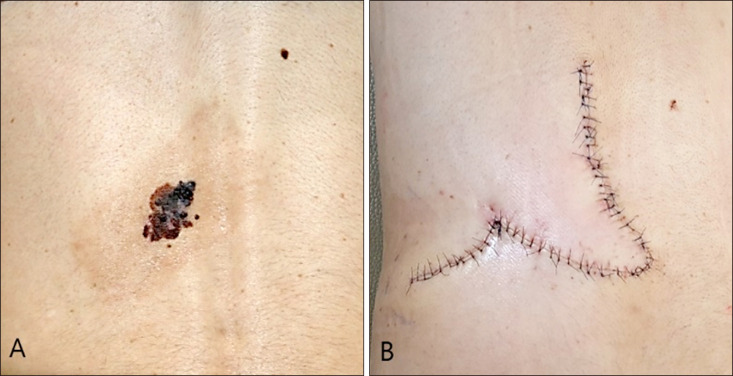Ann Dermatol.
2019 Oct;31(5):525-529. 10.5021/ad.2019.31.5.525.
The Reappraisal of the Slide-Swing Skin Flap: A Versatile Technique for Surgical Defects
- Affiliations
-
- 1Department of Dermatology, Veterans Health Service Medical Center, Seoul, Korea.
- 2Department of Dermatology, Gachon University Gil Medical Center, Incheon, Korea. parkhjmd@naver.com
- KMID: 2456229
- DOI: http://doi.org/10.5021/ad.2019.31.5.525
Abstract
- BACKGROUND
The slide-swing skin flap is a combination of transposition and adjacent skin sliding and can be used to close large, round defects with a flap that is smaller than the primary defect to produce aesthetically good results.
OBJECTIVE
To evaluate the efficacy and safety of the slide-swing skin flap for various surgical defects caused by skin tumor excisions.
METHODS
This retrospective case series, which includes 33 Asian patients between the ages of 25 and 86 years, describes the slide-swing skin flap after primary excision for malignant or premalignant skin conditions. The outcomes were assessed 12 weeks after surgery using the patient and observer scar assessment scale (POSAS).
RESULTS
Patients were 25 male and 8 female, and the causes of surgery were various malignant skin tumors including malignant melanoma, dermatofibrosarcoma protuberans, and malignant nodular hidradenoma. Tumors were on the lower limb in eleven patients, back in nine patients, chest in five patients, face in three patients, buttock in three patients and two patients had tumors in other locations. The mean defect size was 3.5×3.1±1.9×2.2 cm (range, 1.4×0.9~9.0×12.0 cm). The mean patient POSAS total score was 9.7±3.0 and mean patient overall opinion score was 1.8±0.7. The mean observer POSAS total score was 11.0±2.7 and mean observer overall opinion score was 1.9±0.5. All flaps survived and postoperative recoveries were uneventful.
CONCLUSION
The slide-swing skin flap is highly versatile and can be used to cover various surgical defects, irrespective of size and location, with excellent functional and cosmetic results.
Keyword
MeSH Terms
Figure
Reference
-
1. Kwon KH, Lee DG, Koo SH, Jo MS, Shin H, Seul JH. Usefulness of v-y advancement flap for defects after skin tumor excision. Arch Plast Surg. 2012; 39:619–625. PMID: 23233887.
Article2. Schrudde J, Petrovici V. Slide-swing skin flap. In : Strauch B, Hall-Findlay EJ, Grabb WC, Vasconez LO, editors. Grabb's encyclopedia of flaps. Philadelphia: Lippincott;1998. p. 399–402.3. Schrudde J, Petrovici V. The use of slide-swing plasty in closing skin defects: a clinical study based on 1,308 cases. Plast Reconstr Surg. 1981; 67:467–481. PMID: 7208690.4. Schrudde J, Beinhoff U. Covering defects in the breast region by the slide-swing plasty. Aesthetic Plast Surg. 1989; 13:41–46. PMID: 2728998.
Article5. Grekin RC. Flap surgery. In : Lask GP, Moy RL, editors. Principles and techniques of cutaneous surgery. New York: McGraw Hill;1996. p. 309–328.6. Shao K, Parker JC, Taylor L, Mitra N, Sobanko JF. Reliability of the patient and observer scar assessment scale when used with postsurgical scar photographs. Dermatol Surg. 2018; 44:1650–1652. PMID: 29381545.
Article7. Miller CJ. Design principles for transposition flaps: the rhombic (single-lobed), bilobed, and trilobed flaps. Dermatol Surg. 2014; 40 Suppl 9:S43–S52. PMID: 25158876.8. Choi SM, Suh IS, Ha JW. The comparison of the clinical applicability of double z-rhomboid plasty and slide swing plasty. J Korean Soc Aesthetic Plast Surg. 1996; 2:24–31.
- Full Text Links
- Actions
-
Cited
- CITED
-
- Close
- Share
- Similar articles
-
- Reconstructive Modalities According to Aesthetic Consideration of Subunits of the Cheek after Wide Excision of Skin Cancer
- Modified Medial Gastrocnemius Myocutaneous Flap Technique for Knee Joint Coverage after Total Knee Arthroplasty
- Usage of nasolabial skin flaps for the reconstruction of various intraoral defects
- Two Cases of Annular Skin Defects Repaired with Quadruple Fan Flaps (O-X Flap)
- Two Cases of "Pinch Modification" of the Linear Advancement Flap (Peng Flap) in Repair of Round Defects on the Scalp




